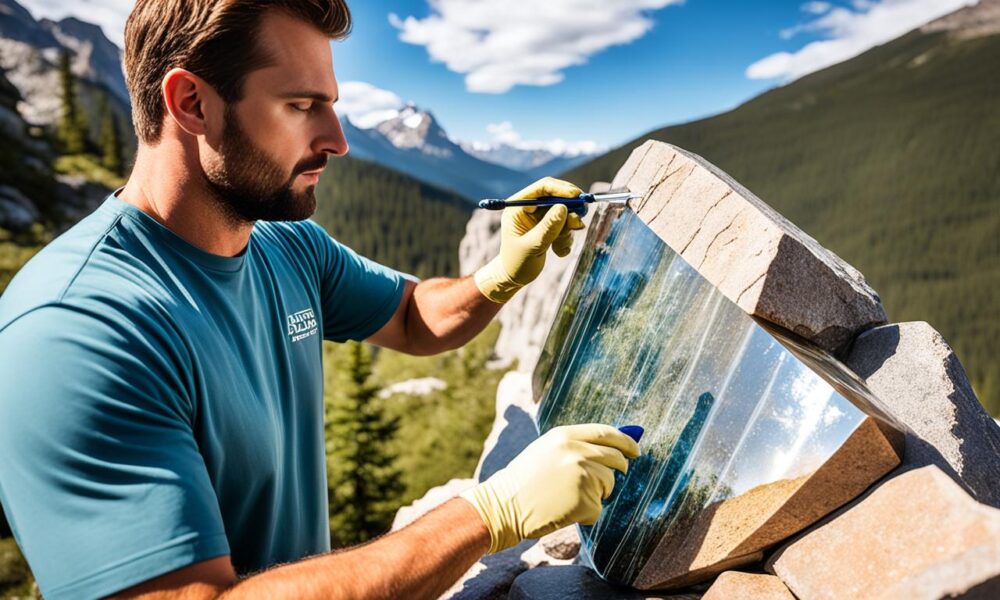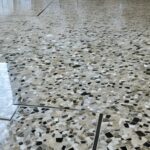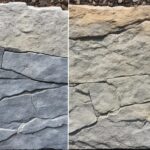Protect Your Natural Stone from Damage and Wear
Natural stone is a timeless choice for many things like countertops and flooring. It’s loved for its beauty and strength. But, it can get damaged by things like acids, oils, and germs. To keep your stone looking great, you need to protect it and take good care of it.
Keeping your natural stone safe from damage is key to keeping it looking good. This article will talk about why protecting your stone is important. We’ll also cover what can damage it and how to stop that. By following these tips, you can keep your stone looking great for a long time, making your place look better and more valuable.
Key Takeaways
- Natural stone is porous and vulnerable to damage from acids, oils, and microorganisms.
- Proper stone maintenance is essential to preserving the beauty and durability of natural stone surfaces.
- Common causes of stone damage include acidic substances, scratches, burns, and staining agents.
- Sealing natural stone can provide added protection against stains, but not against etches.
- A regular stone care program, including daily cleaning and periodic heavy-duty maintenance, is crucial for maintaining natural stone surfaces.
Understanding the Importance of Natural Stone Protection
Natural stone makes any space look beautiful and lasts a long time. But, to keep it looking great, you must protect it from damage and wear. By protecting your stone, it will stay a beautiful part of your home or business for many years.
The Porous Nature of Natural Stone
Natural stone is very porous. It has small holes and crevices that can soak up liquids and oils. This makes it prone to staining and other damage. The porosity of stone varies, with some stones being more prone to damage than others.
Common Causes of Damage and Wear
Many things can harm natural stone surfaces. Some common causes include:
- Exposure to acidic substances like citrus juices, vinegar, and wine
- Scratches from rough shoes or heavy objects
- Burns from hot items placed on the stone
- Stains from spills that aren’t cleaned up quickly
Knowing these risks helps you protect your stone better. By understanding what can damage your stone, you can take steps to prevent it.
Sealing natural stone surfaces makes them more durable. It reduces the risk of scratches, etching, and damage from spills and acidic substances.
Getting professional stone sealing and restoration services helps protect your stone from daily wear and tear. With the right care, your stone will stay beautiful and last a long time in your home or business.
Avoiding Etches, Scratches, Burns, and Stains
Natural stone surfaces are beautiful and strong but can still get damaged. To keep your natural stone looking great, you need to prevent etches, scratches, burns, and stains. By knowing what causes these problems and how to care for your stone, you can keep it looking new for many years.
Keep Acidic Substances Away from Natural Stone
Keeping acidic substances away is key to preventing stone etches. Stones like marble, limestone, onyx, and travertine can etch easily when touched by acids. Things like coffee, tea, wine, citrus juices, and vinegar cleaners can be acidic. Use coasters for drinks, don’t use acidic cleaners, and clean up spills fast to protect your stone.
Use Caution to Prevent Scratches and Burns
To avoid stone scratches and prevent stone burns, be careful and use protective items. Make sure furniture has felt pads and don’t drag heavy things on your stone. Always use trivets or heat-resistant pads for hot items to avoid burns.
Protect Against Common Staining Agents
Common stone stains can come from makeup, cooking oils, and dark foods and drinks. Use coasters, placemats, and cutting boards to protect your stone. If you spill something, quickly blot it with a clean cloth and clean the area with a pH-neutral cleaner made for natural stone. A quick action is key, as acidic liquids can cause both stains and etches, as explained by Use Natural Stone.
For tough stains, you might need to make a poultice. Choose the right chemical for the stain type. Let the poultice dry completely, which can take a day or several days. Remember, oily stains might need up to 4 or 5 tries to remove.
As noted by Natural Stone, new surface treatments have made natural stone last longer and work better. But, taking good care of your stone is still crucial to keep it looking great and lasting long.
Choosing the Proper Cleaning Products
Choosing the right cleaners for natural stone surfaces is key to keeping them looking great. Many household cleaners have harsh chemicals that can damage the stone and remove sealers. It’s important to use cleaners made just for natural stone to protect it.
A pH-neutral cleaner is the best choice for everyday cleaning. These cleaners clean without harming the stone or its sealant. Always test a small area first before cleaning the whole surface.
“Using the wrong cleaning products on natural stone can lead to etching, staining, and dulling of the surface. It’s important to avoid harsh chemicals and opt for stone-safe cleaners to maintain the beauty and integrity of your natural stone surfaces.”
When picking a cleaner for natural stone, look for these things:
- pH-neutral formula
- Specifically designed for natural stone
- Free from acids, bleaches, and abrasives
- Safe for use on sealed and unsealed surfaces
Using the right cleaners and a regular cleaning routine will keep your natural stone looking great. Remember, taking care of your stone now helps it last longer.
How to Protect Your Natural Stone from Damage and Wear
Natural stone is a beautiful and durable choice for countertops, floors, and more in your home. Yet, it’s key to protect it from damage and wear. With the right care, your natural stone can stay stunning for many years.
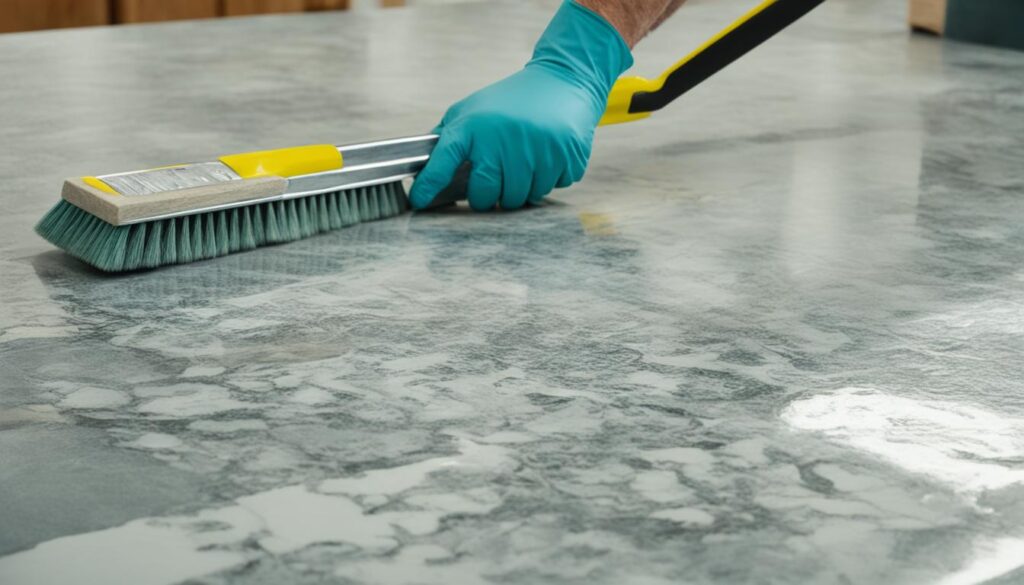
Sealing Natural Stone for Added Protection
Sealing your natural stone is a great way to protect it. It fills the stone’s pores, creating a barrier against liquids and substances that can stain or damage. The porosity of natural stones varies, with granite being denser than other types. It’s vital to pick a sealer that fits your stone type.
Stone countertops often get sealed when installed by the fabricator. But sealers don’t last forever and need to be reapplied. How often depends on the stone type, its spot in your home, and how much wear it gets. Generally, reapply sealer every one to two years, based on its exposure and wear.
Sealing every couple of years will ensure your stone continues to look its best.
Importance of a Regular Maintenance Program
Along with sealing, a regular stone care routine is key to keeping your natural stone looking great. This includes:
- Cleaning with cleaners made for stone
- Avoiding harsh household cleaners that can damage stone
- Not using scouring powders or creams that can scratch the stone
- Acting fast on spills to prevent stains
- Checking outdoor stone for damage to stop further wear
- Not using de-icing salts on stone in winter to avoid erosion
| Stone Type | Porosity Level | Recommended Sealing Frequency |
|---|---|---|
| Granite | Low | Every 1-2 years |
| Marble | Medium | Every 6-12 months |
| Limestone | High | Every 3-6 months |
| Travertine | High | Every 3-6 months |
Follow these tips and a regular maintenance routine to keep your natural stone looking great. If your stone gets stained, eroded, or damaged, professional restoration can fix it.
Sealing Natural Stone: Types and Frequency
Sealing your natural stone surfaces is key to keeping them looking great and lasting long. There are different sealers for various needs, each with its own benefits. Picking the right sealer and sealing often keeps your stone looking new for many years.
Natural-Look Impregnating or Penetrating Sealers
Impregnating sealers, or penetrating sealers, are great for keeping the stone’s natural look. They go deep into the stone, protecting it from stains and moisture without changing its look or color. These sealers work well for both inside and outside, making them a good choice for many types of stone.
Color-Enhancing Sealers
Color-enhancing sealers also go deep into the stone but make it look richer and deeper. They’re perfect for those who love the stone’s natural color but want it to pop more. These sealers are especially good for dark stones like slate or granite, highlighting their beauty.
Topical or Coating Sealers
Topical sealers create a protective layer on the stone’s surface. They can make the stone look brighter and give it a glossy or matte finish. These sealers protect against stains and etching but might make the stone slippery. They’re best used inside and for areas with less foot traffic.
How often you should seal your stone depends on the stone type, where it’s located, and how much it’s used. Here’s a guide to help you figure out when to seal different stones:
| Natural Stone Type | Recommended Sealing Frequency |
|---|---|
| Granite | Every 6 months to 1 year |
| Marble | Every 6 months to 1 year |
| Quartzite | Annually |
| Slate | Annually |
| Outdoor Travertine | Every 1 to 2 years |
| Stone Countertops | Every 1 to 2 years, depending on the stone type |
To check if your stone needs resealing, do a simple water test. Drip some water on the stone and see how fast it soaks in. If it soaks up quickly, it’s time to reseal to keep it protected and looking great.
Effective Maintenance Strategies for Natural Stone
Keeping your natural stone surfaces looking great and lasting long takes a mix of daily care, regular upkeep, and deep cleaning now and then. By using the right strategies for your stone, you can keep its beauty and protect your investment for many years.
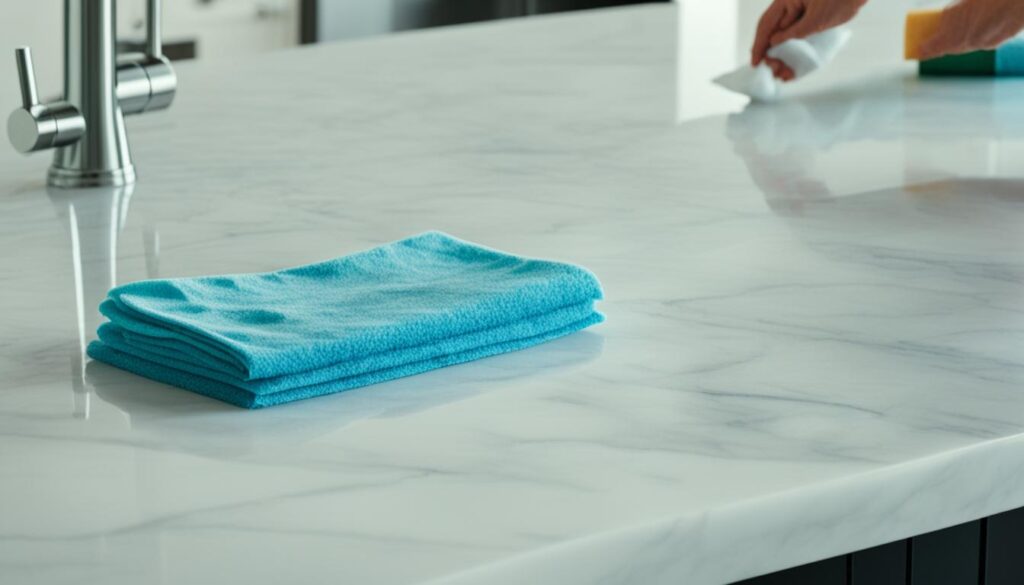
Daily and Routine Cleaning Techniques
Cleaning your stone every day is key to stop dirt, debris, and bacteria from building up. Studies show that granite countertops can have up to 54 billion bacteria per cubic centimeter. To keep your stone clean and safe:
- Dust mop or vacuum often to get rid of loose bits
- Use a damp, soft cloth with a pH-neutral soap for cleaning
- Stay away from harsh cleansers that can scratch or dull the stone
- Make sure to dry surfaces right after cleaning to avoid spots or streaks
Regular quick cleanings stop grime from building up, which could later need harsh scrubbing or professional help. Always use cleaners made for your stone type to avoid damage or discoloration.
Periodic Heavy-Duty Cleaning
Along with regular upkeep, deep cleaning is key for getting rid of tough stains, grease, and deep dirt. How often you need a deep clean depends on where your stone is and how much it’s used. For a deep clean:
- Pick a cleaner made for stone that’s alkaline and right for your stone type
- Test the cleaner in a hidden spot first to make sure it’s safe
- Apply the cleaner as told and let it sit for the time suggested
- Use a soft brush or cloth to work the cleaner into the surface
- Rinse well with clean water and dry with a soft cloth
If you have tough stains or a lot of buildup, you might need a professional stone restoration service. They have the skills and tools to safely and effectively clean your stone.
| Stone Type | Daily Cleaning | Periodic Deep Cleaning |
|---|---|---|
| Granite | pH-neutral cleaner, soft cloth | Every 3-6 months |
| Marble | Mild soap, damp cloth | Every 6-12 months |
| Limestone | Stone-safe cleaner, microfiber cloth | Every 6-12 months |
| Travertine | pH-neutral cleaner, soft mop | Every 3-6 months |
Using a mix of daily cleaning, regular upkeep, and deep cleaning can protect your natural stone from damage, stains, and wear. This approach keeps your stone looking great and enhances your spaces for years.
Covering and Containing to Minimize Damage
Protecting your natural stone surfaces from damage is easy and effective. Use stone protection covers, placemats, coasters, rugs, and mats in the right spots. This helps lower the chance of damage to your beautiful stone surfaces.
In bathrooms and kitchens, where acidic items like toiletries or cleaners are common, use trays, baskets, or bins. These keep items away from your stone countertops. This step prevents etching and staining from spills or harmful substances.
An ounce of prevention is worth a pound of cure. By covering and containing potential hazards, you can save yourself time, money, and heartache in the long run.
For dining tables and coffee tables, use placemats, coasters, and doilies. They protect against water marks, cup rings, and scratches from tableware or decorations. These covers also add a decorative touch to your home.
Stone flooring benefits from area rugs, mats, and runners. Place mats at entryways to catch dirt and debris. Use area rugs in busy areas to reduce stone surface wear and protect against spills and dropped items.
| Stone Protection Cover | Recommended Placement | Benefits |
|---|---|---|
| Placemats and Coasters | Dining Tables, Coffee Tables | Prevents water marks, cup rings, and scratches |
| Trays, Baskets, and Bins | Bathrooms, Kitchens | Keeps acidic materials away from stone countertops |
| Area Rugs and Runners | High-Traffic Zones, Entryways | Reduces wear patterns and protects against spills and dropped items |
Using these stone protection covers in your home greatly lowers the risk of damage to your natural stone surfaces. Remember, being proactive to cover and contain hazards is a smart way to keep your stone looking great for years.
Dealing with Spills and Stains on Natural Stone
Accidents can happen, even with the best care. Spills and stains can still occur on natural stones like marble, granite, and limestone. It’s important to act fast to stop the substance from going deep into the stone. This can lead to tough stains.
The first step in removing stone stains is to blot the spill with a clean cloth. Be careful not to spread the substance further. This can make the stain worse.
Acting Fast to Prevent Staining
Time is crucial when cleaning stone spills. The longer a spill sits, the more likely it is to stain the stone. This is especially true for stones like marble, which soak up liquids quickly.
After blotting the spill, apply a stone-safe cleaning solution. This helps lift any residue and stops it from setting into the stone. Always test the solution on a small area first to make sure it won’t harm the stone.
Using Appropriate Cleaning Solutions
Choosing the right cleaning products is vital for removing stains. Avoid cleaners that are acidic or abrasive, as they can damage the stone. Instead, use pH-neutral, non-abrasive cleaners made for your stone type.
If stains don’t come out with regular cleaners, you might need a specialized product. Or, you could talk to a professional stone restoration expert. They can suggest the best way to remove the stain.
Acting fast, using the right cleaners, and following the right techniques can help minimize the effects of spills and stains. This keeps your natural stone looking great for a long time. Remember, prevention is key. Seal your stone often and maintain it well to avoid stains and damage.

